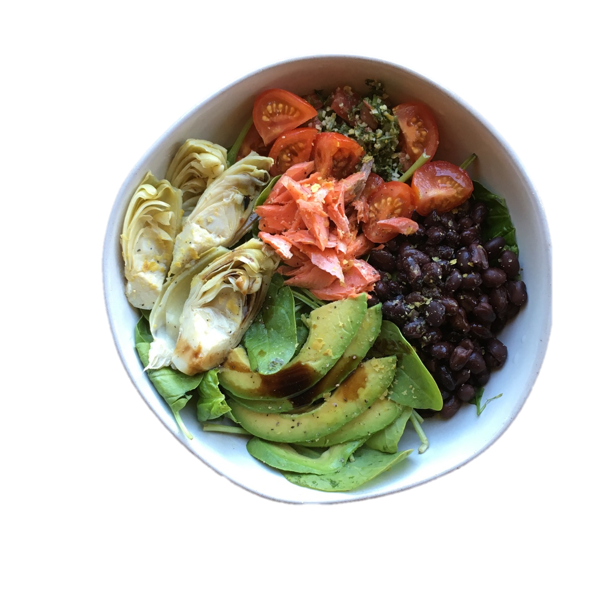One of the core goals of my business, Nutrition Translated, is to “translate” healthy eating into simple and easy daily habits you can practice in any situation. There is no need to get caught up on food trends that come and go, no need to count calories, and no need to agonize over saying goodbye to entire food groups (unless there is a medical reason to do so). Moreover, following a simple and flexible eating framework can help with consistency and adherence to healthy eating habits!
In this blog post you will learn how to put into practice the components of a whole foods diet as we answer the question: How can we build a balanced nourishing plate?
The plate model presented here helps you pack your meals with the wonderful nutrients your body needs to keep you energized and satiated until the next meal. This plate model is centered around the PFF framework I have introduced you to in previous posts (PFF = protein, fat, fiber).
We can build a balanced wholesome plate by combining the following:
NON-STARCHY CARBS + STARCHY CARBS + LEAN PROTEIN + HEALTHY FAT + FLAVOR ADD ONS
This model works because it delivers the nutrients your body needs while also allowing for flexibility and personal preferences. You can use this model to build a nourishing plate centered around whole foods whether you follow an omnivore, vegetarian, or vegan diet.
GENERAL RECOMMENDATIONS
The following recommendations are a guideline. Please keep in mind the goal is to choose whole or minimally processed foods as much a possible. Stressing too much over the details can become cumbersome and overwhelming.
And remember, each of us has a different relationship with food based on factors such as family and cultural traditions, food allergies and sensitivities, and health goals. These factors will determine the specifics of what goes onto our plates within the whole foods dietary framework.
HOW CAN WE BUILD A BALANCED NOURISHING PLATE?
*Half of the plate contains non-starchy carbohydrates, namely vegetables. Use a combination of raw and cooked vegetables. Aim for diversity and color (eat the rainbow!). Cruciferous vegetables such as broccoli and brussels sprouts are recommended daily. Fermented vegetables such as kimchi are also recommended daily. Choose seasonal, organic, and local vegetables whenever possible. These non-starchy carbohydrates also provide a great source of dietary fiber.
Examples: dark green leafy vegetables, (spinach, chard, kale, collards), lettuce, broccoli, bok choy, cauliflower, onion, garlic, leeks, Brussels sprouts, carrots, celery, asparagus, bell peppers, cucumber, tomatoes, and mushrooms.
*One quarter of the plate contains lean protein. This can come in the form of minimally processed meats (choose organic and grass fed, pastured raised when possible), wild caught fish or seafood, minimally processed and organic soy products (e.g. tofu or tempeh), or beans/legumes. Legumes are a very nutrient dense food; they are a great source of fiber, antioxidants, minerals, and vitamins.
A daily serving of organic dairy may be included as a source of protein (and fat) based on individual preferences and tolerance. For example: kefir, yogurt, fermented cheese.
*One quarter of the plate contains starchy carbohydrates like whole grains and/or starchy vegetables. When eating starchy vegetables, it is recommended to combine them with a healthy fat (e.g. sweet potatoes combined with mashed avocado, coconut oil, or olive oil) to decrease blood sugar spikes and increase satiety. Adding fat also helps increase the absorption of fat-soluble vitamins found in vegetables (Vitamins A, D, E, K).
Examples: all whole grains such as brown rice, corn, quinoa, and oats. Starchy vegetables like yams, sweet potato, beets, or squash.
*Healthy fats. These can be incorporated in the form of whole foods or as quality oils for cooking or dressings. For example, they may be added to the meal as a part of a salad or salad dressing or as a topping for your oatmeal.
Examples: nuts, seeds, olives, avocados, salmon, mackerel, anchovies, sardines, herring, dry coconut, extra virgin olive oil, avocado oil, and a moderate amount of coconut oil.
*Flavor add-ons: Use herbs, spices, and condiments to keep flavors interesting and add variety to the meals. I can’t overemphasize the magic of turning ingredients into completely different dishes thanks to the condiments used for flavoring. This is so helpful if you want to batch cook food components and then mix and match them into different dishes.
Examples: fresh and dry herbs like rosemary, sage, thyme, parsley, cilantro, chives, basil, or tarragon. Spices such as black pepper, cayenne, cumin, turmeric, ginger, fennel, cinnamon, and pumpkin spice.
*Drink water through the day. Don’t wait to be thirsty! Other healthful beverage options include unsweetened herbal tea, green/black tea, or coffee (if not sensitive to caffeine).
In this blog post you will learn how to put into practice the components of a whole foods diet as we answer the question: How can we build a balanced nourishing plate?
The plate model presented here helps you pack your meals with the wonderful nutrients your body needs to keep you energized and satiated until the next meal. This plate model is centered around the PFF framework I have introduced you to in previous posts (PFF = protein, fat, fiber).
We can build a balanced wholesome plate by combining the following:
NON-STARCHY CARBS + STARCHY CARBS + LEAN PROTEIN + HEALTHY FAT + FLAVOR ADD ONS
This model works because it delivers the nutrients your body needs while also allowing for flexibility and personal preferences. You can use this model to build a nourishing plate centered around whole foods whether you follow an omnivore, vegetarian, or vegan diet.
GENERAL RECOMMENDATIONS
The following recommendations are a guideline. Please keep in mind the goal is to choose whole or minimally processed foods as much a possible. Stressing too much over the details can become cumbersome and overwhelming.
And remember, each of us has a different relationship with food based on factors such as family and cultural traditions, food allergies and sensitivities, and health goals. These factors will determine the specifics of what goes onto our plates within the whole foods dietary framework.
HOW CAN WE BUILD A BALANCED NOURISHING PLATE?
*Half of the plate contains non-starchy carbohydrates, namely vegetables. Use a combination of raw and cooked vegetables. Aim for diversity and color (eat the rainbow!). Cruciferous vegetables such as broccoli and brussels sprouts are recommended daily. Fermented vegetables such as kimchi are also recommended daily. Choose seasonal, organic, and local vegetables whenever possible. These non-starchy carbohydrates also provide a great source of dietary fiber.
Examples: dark green leafy vegetables, (spinach, chard, kale, collards), lettuce, broccoli, bok choy, cauliflower, onion, garlic, leeks, Brussels sprouts, carrots, celery, asparagus, bell peppers, cucumber, tomatoes, and mushrooms.
*One quarter of the plate contains lean protein. This can come in the form of minimally processed meats (choose organic and grass fed, pastured raised when possible), wild caught fish or seafood, minimally processed and organic soy products (e.g. tofu or tempeh), or beans/legumes. Legumes are a very nutrient dense food; they are a great source of fiber, antioxidants, minerals, and vitamins.
A daily serving of organic dairy may be included as a source of protein (and fat) based on individual preferences and tolerance. For example: kefir, yogurt, fermented cheese.
*One quarter of the plate contains starchy carbohydrates like whole grains and/or starchy vegetables. When eating starchy vegetables, it is recommended to combine them with a healthy fat (e.g. sweet potatoes combined with mashed avocado, coconut oil, or olive oil) to decrease blood sugar spikes and increase satiety. Adding fat also helps increase the absorption of fat-soluble vitamins found in vegetables (Vitamins A, D, E, K).
Examples: all whole grains such as brown rice, corn, quinoa, and oats. Starchy vegetables like yams, sweet potato, beets, or squash.
*Healthy fats. These can be incorporated in the form of whole foods or as quality oils for cooking or dressings. For example, they may be added to the meal as a part of a salad or salad dressing or as a topping for your oatmeal.
Examples: nuts, seeds, olives, avocados, salmon, mackerel, anchovies, sardines, herring, dry coconut, extra virgin olive oil, avocado oil, and a moderate amount of coconut oil.
*Flavor add-ons: Use herbs, spices, and condiments to keep flavors interesting and add variety to the meals. I can’t overemphasize the magic of turning ingredients into completely different dishes thanks to the condiments used for flavoring. This is so helpful if you want to batch cook food components and then mix and match them into different dishes.
Examples: fresh and dry herbs like rosemary, sage, thyme, parsley, cilantro, chives, basil, or tarragon. Spices such as black pepper, cayenne, cumin, turmeric, ginger, fennel, cinnamon, and pumpkin spice.
*Drink water through the day. Don’t wait to be thirsty! Other healthful beverage options include unsweetened herbal tea, green/black tea, or coffee (if not sensitive to caffeine).
A BALANCED PLATE IN PRACTICE
Non starchy carbohydrates: spinach, tomatoes, artichokes
Starchy carbohydrates: black beans (also a source of protein and fiber)
Protein: wild sockeye salmon (also a source of healthy omega-3 fats)
Fat: avocado and extra virgin olive oil
Flavor add-on: sea salt, black pepper, parsley, garlic, nutritional yeast, and balsamic vinegar
Remember this plate model is meant to serve as a guideline and a flexible framework.
Sometimes you may not be able to balance your plate this way, depending on what’s available at the time! This is completely normal and should not be seen as a “failure” or “falling off the wagon”. There is no wagon in a sustainable lifestyle. Our health journey will not be derailed by the occasional unbalanced meal. Positive health outcomes are associated with long term dietary habits so if you use these principles most of the time, the occasional meal out or piece of cake are not something to overthink.
SEASONAL RECIPES TO ENJOY THIS WEEK!
*White bean and lemon kale soup
*Riced parsnip and chicken
*Herbed roasted turnip
*Sausage and sauerkraut skillet
NUTRITION FUN FOR THE KIDDOS
*Make a balanced plate collage! Cut out food from grocery store ads. Glue the pictures to a paper plate or draw a plate on a piece of paper.
*Use dry beans to make the letters of your name.
*Cut out all the veggies you can find in a magazine and use them to make a rainbow.
*Science: float or sink? Fill a plastic container with 2-4 inches of water. Then figure out which veggies float and which ones sink.
Non starchy carbohydrates: spinach, tomatoes, artichokes
Starchy carbohydrates: black beans (also a source of protein and fiber)
Protein: wild sockeye salmon (also a source of healthy omega-3 fats)
Fat: avocado and extra virgin olive oil
Flavor add-on: sea salt, black pepper, parsley, garlic, nutritional yeast, and balsamic vinegar
Remember this plate model is meant to serve as a guideline and a flexible framework.
Sometimes you may not be able to balance your plate this way, depending on what’s available at the time! This is completely normal and should not be seen as a “failure” or “falling off the wagon”. There is no wagon in a sustainable lifestyle. Our health journey will not be derailed by the occasional unbalanced meal. Positive health outcomes are associated with long term dietary habits so if you use these principles most of the time, the occasional meal out or piece of cake are not something to overthink.
SEASONAL RECIPES TO ENJOY THIS WEEK!
*White bean and lemon kale soup
*Riced parsnip and chicken
*Herbed roasted turnip
*Sausage and sauerkraut skillet
NUTRITION FUN FOR THE KIDDOS
*Make a balanced plate collage! Cut out food from grocery store ads. Glue the pictures to a paper plate or draw a plate on a piece of paper.
*Use dry beans to make the letters of your name.
*Cut out all the veggies you can find in a magazine and use them to make a rainbow.
*Science: float or sink? Fill a plastic container with 2-4 inches of water. Then figure out which veggies float and which ones sink.
| Seasonal Recipes.pdf |


 RSS Feed
RSS Feed